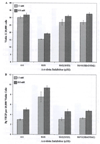A possible role of acrolein in diabetic retinopathy: involvement of a VEGF/TGFβ signaling pathway of the retinal pigment epithelium in hyperglycemia
- PMID: 22906079
- PMCID: PMC4482234
- DOI: 10.3109/02713683.2012.713152
A possible role of acrolein in diabetic retinopathy: involvement of a VEGF/TGFβ signaling pathway of the retinal pigment epithelium in hyperglycemia
Abstract
Purpose: Acrolein has been implicated in retinal pigment epithelium (RPE) cell death, and has been associated with diabetic retinopathy. Our purpose was to investigate the potential effect of high glucose in influencing acrolein-mediated RPE cytokine production and cell death. We investigated the influence of the acrolein effect on ARPE-19 cells in high glucose conditions and quantified the release of transforming growth factor β (TGFβ1 and 2) and vascular endothelial growth factor (VEGF). We assessed the ability of N-benzylhydroxylamine(NBHA) as well as TGFβ pathway inhibitors SIS3 and SB431542 to prevent this effect of acrolein on ARPE-19 cells.
Materials and methods: Confluent ARPE-19 cells were treated with acrolein and/or NBHA in both 5.5 and 18.8 mM glucose conditions. Cells were also pretreated with SIS3, a specific inhibitor of the SMAD3 pathway, and SB431542, a specific inhibitor of TGFβ signaling pathway, before treating them with acrolein. Viable cells were counted and ELISAs were performed to measure the cytokines TGFβ1 and 2, and VEGF released into the conditioned media.
Results: In ARPE-19 cells exposed to acrolein and hyperglycemia there was reduced cell viability and an increase in the cell media of VEGF, TGFβ1, and TGFβ2, which was reversed by NBHA. Acrolein/hyperglycemia-induced cell viability reduction and cytokine overproduction was also reduced by TGFβ pathway blockade.
Conclusions: We conclude that the effect of acrolein on the reduction of viability and VEGF increase by ARPE-19 cells in hyperglycemic media is conducted through the TGFβ signaling pathway. Our results suggest that benefits of sequestering acrolein by NBHA and the blockage of the TGFβ pathway by SB431542 and SIS3 offer suggestions as to potential useful pharmacological drug candidates for the prevention of diabetes-induced complications in the eye.
Conflict of interest statement
Figures



References
-
- Esterbauer H, Schaur RJ, Zollner H. Chemistry and biochemistry of 4-hydroxynonenal, malonaldehyde and related aldehydes. Free Radic Bid Med. 1991;11:81–128. - PubMed
-
- Uchida K. Current status of acrolein as a lipid peroxidation product. Trends Cardiovasc Med. 1999;9:109–113. - PubMed
-
- Bazan NG. Survival signaling in retinal pigment epithelial cells in response to oxidative stress: significance in retinal degenerations. Adv Exp Med Biol. 2006;572:531–540. - PubMed
Publication types
MeSH terms
Substances
Grants and funding
LinkOut - more resources
Full Text Sources
Other Literature Sources
Medical
